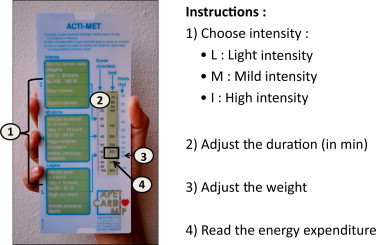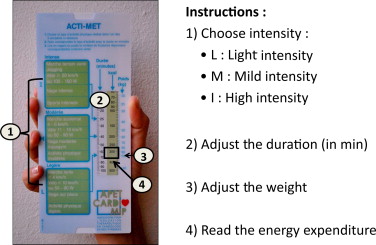Abstract
Objective
We created a tool for assessing physical activity (PA), the Acti’MET ® calculator, to quickly estimate weekly energy expenditure. This study aimed to assess the metrological properties of the tool in cardiac rehabilitation (CR).
Methods
Two examiners evaluated the reliability and concurrent validity of the tool with cardiac patients. The validity of the tool was assessed by comparison with other classical methods for measurement of PA such as the Dijon Physical Activity Score (PAS) and the International Physical Activity Questionnaire (IPAQ) score, the 6-min walk test (6MWT) and the cardiopulmonary maximal exercise test. Correlation was assessed by Pearson or Spearman correlation analysis.
Results
For the 36 cardiac patients (mean age 55 ± 11 years, 24 men), inter-rater and intra-rater reliabilities were strong: r = 0.87 and r = 0.98, respectively, both P < 0.0001. We found a strong correlation of the Acti’MET ® score with the IPAQ score ( r = 0.88, P < 0.0001), moderate correlation with the PAS ( r = 0.39, P < 0.05) and 6MWT ( r = 0.54, P < 0.01), and no correlation with peak power output.
Conclusion
The Acti’MET ® calculator is reliable, valid and easy to use for assessing PA in CR. This tool seems to well reflect the weekly PA, unlike the PAS, which evaluates PA on a yearly basis.
1
Introduction
One of the main challenges of cardiac rehabilitation (CR) is to engage patients in long-term recommended physical activity (PA) because adherence to these recommendations after CR remains low . Paradoxically, in clinical practice, PA is rarely assessed by health professionals or the patients themselves possibly because of lack of appropriate and user-friendly tools. Energy expenditure (EE) is a reliable way to quantify the PA because it synthesizes a large number of PA variables (volume, intensity, duration). To prevent secondary events, the recommended target amount of PA is a minimum of 1000 kcal per week divided into at least 3 sessions, approximately equivalent to 150 min of exercise per week at moderate intensity .
The Compendium of Physical Activities allows for quantifying EE as a multiple of baseline metabolism (metabolic equivalent task [MET], defined by EE assessed in adult healthy subjects seated and at rest) depending on PA intensity and duration. Although estimating MET may be subject to some inter-individual variabilities (age, sex and disease), this model, widely used in research, is a reliable and accurate way to estimate the EE related to PA. However, the Compendium remains underused in clinical practice because it is difficult to use.
Our team used the Compendium to create a new tool for PA assessment in CR, the Acti’MET ® calculator, to quickly estimate weekly EE and help with PA prescription. We created this tool after a complete analysis of the literature with participation of local experts in cardiology, physical activity and therapeutic education. This tool can also be an educational tool to help patients in self-assessment and adapt their PA according to their way of life.
The main objective of this study was to test the metrological properties of the Acti’MET ® calculator in CR. We first tested its reliability (inter-rater and intra-rater reliability), then its validity (correlation of scores with those of other measurement tools).
2
Methods
2.1
Subjects
The protocol was suggested to patients referred to our CR unit at the beginning of their ambulatory CR program. Patients had to have stable acute coronary disease, chronic heart failure or valvular disease. Patients with speech and comprehension problems were excluded, as were patients with limitations of PA because of diseases other than cardiovascular disorders.
2.2
Study design
Assessments were mainly routine tests used in CR clinical practice. For organizational reasons and to not overload patients with too many tests, we used 2 assessment times. First, at the beginning of the CR, we tested the inter-rater and intra-rater reliability of the tool. Acti’MET ® assessment involved an individual interview with 2 different examiners in a random order (day 0 [D0]; examiners 1 and 2) and then 3 days later (D1), an interview with examiner 1. Second, at the end of the CR, we tested the validity of the tool with the usual PA assessment tools (physical tests and global physical activity questionnaires). The 2 examiners were trained to use Acti’MET ® in the same way and started to use the tool in their clinical practice 1 month before the beginning of validation protocol.
2.3
Measurements
2.3.1
Acti’MET ® calculator
Acti’MET ® is a small sliding ruler (21.5 × 9 cm) that is easy to use ( Fig. 2 ). PA is grouped into 3 intensity levels: light, < 3 METs; moderate 3 to 6 METs; and vigorous, > 6 METs. For each activity performed, an intensity is chosen, then the duration of the activity is determined (in min) by using the sliding part of the calculator. Finally, the EE associated with the weight of the subject is read. The back of the tool contains the weekly EE recommendations.

2.3.2
Physical tests
Functional capacity was evaluated at the end of the CR. We used the 6-min walk test (6MWT), which is commonly used and validated in CR . This test is performed according to standard recommendations, in particular at the preferred speed to walk the longest distance in 6 min . Results were converted to percentage of theoretical by a formula taking into account age, sex, weight and size of the subject . Patients also performed a cardiovascular maximal exercise test on a cycle ergometer as follows: 10 W/min to maximal supported workload according to traditional criteria of arrest .
2.3.3
Global PA questionnaires
During the final individual interviews, we used validated questionnaires to assess PA: the Dijon Physical Activity Score (PAS) and the International Physical Activity Questionnaire (IPAQ; short French version) . The PAS evaluates PA during the previous year; scores range from 1 to 30, a high score indicating high PA. The IPAQ is one of the most often used PA questionnaires in rehabilitation and, like the Acti’MET ® , is based on the Compendium of Physical Activities and evaluates PA during 1 week.
2
Methods
2.1
Subjects
The protocol was suggested to patients referred to our CR unit at the beginning of their ambulatory CR program. Patients had to have stable acute coronary disease, chronic heart failure or valvular disease. Patients with speech and comprehension problems were excluded, as were patients with limitations of PA because of diseases other than cardiovascular disorders.
2.2
Study design
Assessments were mainly routine tests used in CR clinical practice. For organizational reasons and to not overload patients with too many tests, we used 2 assessment times. First, at the beginning of the CR, we tested the inter-rater and intra-rater reliability of the tool. Acti’MET ® assessment involved an individual interview with 2 different examiners in a random order (day 0 [D0]; examiners 1 and 2) and then 3 days later (D1), an interview with examiner 1. Second, at the end of the CR, we tested the validity of the tool with the usual PA assessment tools (physical tests and global physical activity questionnaires). The 2 examiners were trained to use Acti’MET ® in the same way and started to use the tool in their clinical practice 1 month before the beginning of validation protocol.
2.3
Measurements
2.3.1
Acti’MET ® calculator
Acti’MET ® is a small sliding ruler (21.5 × 9 cm) that is easy to use ( Fig. 2 ). PA is grouped into 3 intensity levels: light, < 3 METs; moderate 3 to 6 METs; and vigorous, > 6 METs. For each activity performed, an intensity is chosen, then the duration of the activity is determined (in min) by using the sliding part of the calculator. Finally, the EE associated with the weight of the subject is read. The back of the tool contains the weekly EE recommendations.


Stay updated, free articles. Join our Telegram channel

Full access? Get Clinical Tree





